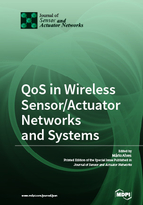QoS in Wireless Sensor/Actuator Networks and Systems
A special issue of Journal of Sensor and Actuator Networks (ISSN 2224-2708). This special issue belongs to the section "Wireless Control Networks".
Deadline for manuscript submissions: closed (30 April 2017) | Viewed by 82761
Special Issue Editor
Interests: QoS (reliability, timeliness, mobility) in low-power wireless networks; sensor/actuator networks; cyber-physical systems
Special Issues, Collections and Topics in MDPI journals
Special Issue Information
Dear Colleagues,
Wireless communication technologies have long since entered our daily lives: from remote controls to baby monitors, from cellular to local area networks. However, industrialists have been very conservative in allowing wireless devices to enter their factory automation and process control systems. This is mainly because "wireless" had only been used for very specific and limited scenarios (e.g. to facilitate point-to-point connections) and did not guarantee reliability, security or lifetime success.
As wireless technology matured (e.g. WiFi and WirelessHART), wireless sensors, actuators and controllers started penetrating the factory floor, replacing or complementing their wired counterparts. While these "hybrid" wired/wireless systems are already a commodity, we are at the dawn of a new era, where computers, sensors and actuators are becoming increasingly embedded and ubiquitous, scaling up systems to unprecedented levels. Consequently, the number of (embedded, networked) devices will grow dramatically while the size of individual devices/nodes will necessarily have to shrink. The “Internet-of-Things” and “Industry 4.0” are very broad umbrellas that encompass this paradigm.
Wireless sensor/actuator networks (WSANs) are thus being increasingly used in a panoply of applications, such as in industrial automation, process control, ambient assisted living, structural health monitoring or homeland security. Most of these applications require stringent Quality-of-Service (QoS) guarantees from their underlying communication infrastructures (regardless of their wireless, wired or hybrid nature). While QoS has been traditionally associated with bit/data rate, network throughput, message delay and bit/packet error rate, these properties alone do not reflect the overall “quality of the service” that needs to be provided to this type of application (and their users). Other (non-functional) properties such as scalability, security, mobility or energy sustainability must also be considered in the design of such complex cyber–physical systems.
This Special Issue targets scientific contributions on wireless sensor/actuator networks and systems (WSANs) addressing QoS properties (hopefully in combination) such as reliability and robustness, timeliness and real-time, scalability, mobility, security and privacy, and energy efficiency and sustainability. We particularly seek papers concerning long-standing cases that have been sufficiently tested and evaluated, either through analytical, simulation or experimental models (hopefully in combination). Extensions to previously published works are accepted, provided that this fact is clearly stated in the submission and the new contribution is significant.
In this context, we are envisaging works covering one or more of the following WSAN topics, with QoS as an overall concern and overarching aspect:
-
System architectures: e.g. improving hardware (e.g. radio technology), software (including operating systems) and communication network architectures to achieve better QoS; scalability; WSAN integration in and interoperability with legacy wired systems; cross-layer design.
-
Reliability and robustness: improving communication errors detection/correction, hardware robustness, systems reliability in general.
-
Timeliness and real-time: improving the timing behavior and reducing/bounding (end-to-end) communication delays, innovative time synchronization techniques
-
Security and privacy: new mechanisms to grant adequate levels of security/privacy without jeopardizing energy and time.
-
Mobility: mechanisms to support mobile devices in a seamless and transparent way, i.e. still respecting the overall QoS requirements.
-
Energy sustainability, efficiency and harvesting: improving devices/system lifetime, e.g. through optimized communications scheduling/duty-cycling and energy/delay trade-offs.
-
Radio interference identification and mitigation: improving the detection, classification and mitigation of communication errors deriving from radio propagation and interference.
-
Communication and network protocols: QoS add-ons, performance/worst-case analysis (analytical, simulation, experimental).
-
QoS in the Internet-of-Things, Cyber-Physical Systems and Industry 4.0 contexts
-
Experimental facilities and test-beds, pilot demonstrations/deployments; innovative simulation and emulation models, platforms and methodologies.
-
Real-world applications, such as in smart health, environmental/structural monitoring, factory automation, process control, smart buildings, body sensor networks, vehicular networks or security/surveillance.
-
Communication standards and technologies for WSAN, e.g. IEEE 802.11, WiFi, IEEE 802.15.4, ZigBee, 6loWPAN, WirelessHART, ISA SP100, MQTT, DASH7, SigFox, LoRa and their integration/interoperability with wired networks.
-
Novel communication technologies to overcome an increasingly overcrowded radio spectrum (e.g. visible light, mm-wave, thermal, vibration, acoustic) communication.
Prof. Dr. Mário Alves
Guest Editor
Manuscript Submission Information
Manuscripts should be submitted online at www.mdpi.com by registering and logging in to this website. Once you are registered, click here to go to the submission form. Manuscripts can be submitted until the deadline. All submissions that pass pre-check are peer-reviewed. Accepted papers will be published continuously in the journal (as soon as accepted) and will be listed together on the special issue website. Research articles, review articles as well as short communications are invited. For planned papers, a title and short abstract (about 100 words) can be sent to the Editorial Office for announcement on this website.
Submitted manuscripts should not have been published previously, nor be under consideration for publication elsewhere (except conference proceedings papers). All manuscripts are thoroughly refereed through a single-blind peer-review process. A guide for authors and other relevant information for submission of manuscripts is available on the Instructions for Authors page. Journal of Sensor and Actuator Networks is an international peer-reviewed open access semimonthly journal published by MDPI.
Please visit the Instructions for Authors page before submitting a manuscript. The Article Processing Charge (APC) for publication in this open access journal is 2000 CHF (Swiss Francs). Submitted papers should be well formatted and use good English. Authors may use MDPI's English editing service prior to publication or during author revisions.






